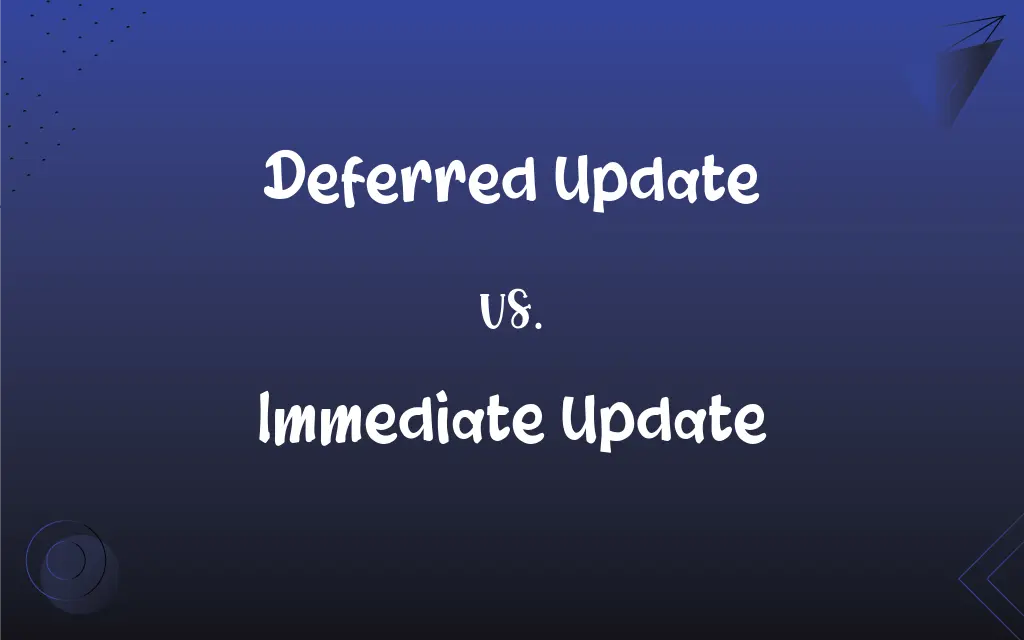Deferred Update vs. Immediate Update: What's the Difference?
Edited by Aimie Carlson || By Janet White || Published on January 3, 2024
Deferred updates apply changes at a later time, often for efficiency, while immediate updates apply changes instantly, ensuring current data.

Key Differences
Deferred updates, commonly used in computing and data management, involve postponing changes to a later time. This method allows for batch processing of updates, which can be more efficient in certain scenarios. Conversely, immediate updates refer to the process of applying changes as soon as they occur, ensuring that data is always current and up-to-date.
In the context of databases, a deferred update strategy means that modifications made by a transaction are temporarily stored and only made permanent when the transaction successfully completes. Immediate updates, on the other hand, involve writing changes to the database directly and instantly as they happen, which can be crucial for real-time data requirements.
Deferred updates can be beneficial in systems where consistency and load balancing are more critical than real-time data accuracy. It allows for aggregating multiple changes and applying them together, potentially reducing system load. Immediate updates are essential in systems where up-to-date information is critical, such as in online banking or stock trading platforms.
The choice between deferred and immediate updates often depends on the application's needs for consistency, performance, and real-time processing. Deferred updates might lead to temporary inconsistencies but can improve overall performance. Immediate updates ensure data integrity at the expense of potential increased system load.
Deferred updates offer a strategic advantage in managing system resources and performance, while immediate updates prioritize data accuracy and timeliness. The choice between them depends on the specific requirements and constraints of the system in question.
ADVERTISEMENT
Comparison Chart
Timing of Changes
Applied later, often in batches
Applied instantly as they occur
Impact on Performance
Can improve performance by reducing load
May increase load due to instant processing
Data Accuracy
May lead to temporary inconsistencies
Ensures data is always current
Use Cases
Useful in systems where efficiency is prioritized
Crucial for real-time data systems
System Load
Reduces immediate system load
Can increase system load
ADVERTISEMENT
Deferred Update and Immediate Update Definitions
Deferred Update
Deferred update refers to applying changes after a certain condition or event.
The system implemented deferred updates to synchronize data during off-peak hours.
Immediate Update
In immediate update, changes are made permanent as soon as they are initiated.
The GPS navigation system used immediate updates for accurate route information.
Deferred Update
In deferred update, changes are stored temporarily before being made permanent.
Deferred updates allowed the application to maintain performance during peak usage times.
Immediate Update
Immediate update refers to the real-time application of changes in a system.
To provide up-to-date news, the website implemented immediate updates for its content.
Deferred Update
Deferred update is the postponement of changes to a later time in a system.
The database used a deferred update approach to handle the high volume of transactions efficiently.
Immediate Update
An immediate update is a method where changes are directly and instantly processed.
Immediate updates ensured that the online banking platform always displayed current account balances.
Deferred Update
A deferred update is a method where changes are aggregated and applied collectively.
In order to optimize network usage, the software performed deferred updates every hour.
Immediate Update
Immediate update means applying changes instantly in a system.
The stock trading application required immediate updates for real-time price information.
Deferred Update
Deferred update is a strategy to manage system resources by delaying updates.
To reduce server load, deferred updates were scheduled during nighttime maintenance.
Immediate Update
Immediate update is a strategy to ensure data accuracy and timeliness.
The emergency alert system was designed for immediate updates to deliver timely warnings.
FAQs
Do deferred updates affect system performance?
Yes, deferred updates can improve system performance by reducing immediate load.
What is a deferred update?
A deferred update is a process where changes are applied at a later time instead of immediately.
When is a deferred update preferred?
Deferred updates are preferred in scenarios where system performance and efficiency are priorities.
What is an immediate update?
An immediate update is the instant application of changes in a system or software.
Can deferred updates lead to delayed information?
Yes, since updates are not immediate, there can be a delay in reflecting the latest information.
What are the risks of deferred updates?
The main risk is temporary data inconsistency and potential delays in critical information.
Are immediate updates more resource-intensive?
Yes, they can be more resource-intensive due to the need for constant data processing.
Why are immediate updates important?
Immediate updates are important for applications that require real-time data accuracy, like financial systems.
Can immediate updates lead to increased system load?
Yes, immediate updates can increase system load due to the need for instant processing.
How do deferred updates manage data consistency?
Deferred updates may lead to temporary data inconsistencies but are managed through batch processing.
Are immediate updates suitable for all systems?
No, immediate updates may not be suitable for systems where high efficiency and less frequent data refresh is acceptable.
Can immediate updates affect the accuracy of data?
Yes, immediate updates ensure that data remains accurate and up-to-date.
Is an immediate update strategy more complex to implement?
It can be more complex due to the need for robust systems to handle real-time data processing.
How do immediate updates benefit user experience?
Immediate updates provide users with the most current data, enhancing real-time interaction.
How do deferred updates impact database transactions?
Deferred updates can optimize database transactions by processing them in batches.
How do users perceive immediate updates?
Users typically perceive immediate updates as providing a more responsive and current experience.
How do deferred updates affect backup processes?
Deferred updates can simplify backup processes by reducing the frequency of data changes.
What scenarios are not suitable for deferred updates?
Scenarios requiring real-time data, like emergency services, are not suitable for deferred updates.
Can deferred updates save resources?
Yes, by aggregating changes, they can save computational and network resources.
Are immediate updates always the best choice for web applications?
Not always, as the choice depends on the specific needs and context of the application.
About Author
Written by
Janet WhiteJanet White has been an esteemed writer and blogger for Difference Wiki. Holding a Master's degree in Science and Medical Journalism from the prestigious Boston University, she has consistently demonstrated her expertise and passion for her field. When she's not immersed in her work, Janet relishes her time exercising, delving into a good book, and cherishing moments with friends and family.
Edited by
Aimie CarlsonAimie Carlson, holding a master's degree in English literature, is a fervent English language enthusiast. She lends her writing talents to Difference Wiki, a prominent website that specializes in comparisons, offering readers insightful analyses that both captivate and inform.






































































